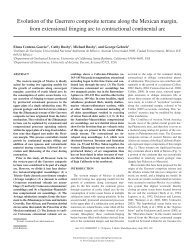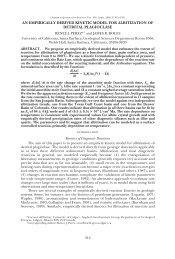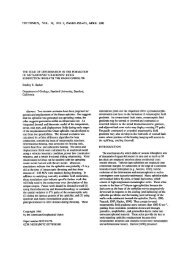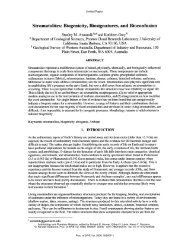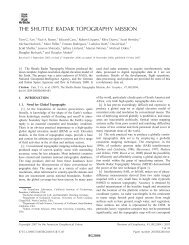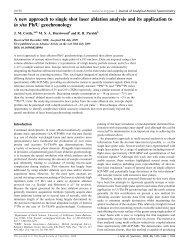K.J. Spencer et al. / Chemical Geology 341 (2013) 84–101101Koons, P.O., Rubie, D.C., Frueh-Green, G., 1987. The effects of disequilibrium and deformationon the mineralogical evolution of quartz diorite during metamorphism in the eclogitefacies. Journal of Petrology 28, 679–700.Krabbendam, M., Wain, A., Andersen, T.B., 2000. Pre-Caledonian granulite and gabbroenclaves in the Western Gneiss Region, Norway: indications of incomplete transitionat high pressure. Geological Magazine 137, 235–255.Kramers, J., Frei, R., Newville, M., Kober, B., Villa, I., 2009. On the valency state of radiogeniclead in zircon and its consequences. Chemical Geology 261, 4–11.Krogh, E.J., 1977. Evidence of Precambrian continent–continent collision in WesternNorway. Nature 267, 17–19.Krogh, E.J., 1980. Compatible P–T conditions for eclogites and surrounding gneisses inthe Kristiansund area, western Norway. Contributions to Mineralogy and Petrology75, 387–393.Krogh, T., Kamo, S.L., Robinson, P., Terry, M.P., Kwok, Y., 2011. U–<strong>Pb</strong> zircon geochronologyof eclogites from the Scandian Orogen, northern Western Gneiss Region, Norway:14–20 million years between eclogite crystallization and return to amphibolitefaciesconditions. Canadian Journal of <strong>Earth</strong> <strong>Science</strong>s 48, 441–472.Kylander-Clark, A.R.C., Hacker, B.R., Johnson, C.M., Beard, B.L., Mahlen, N.J., 2009. Slowsubduction of a thick ultrahigh-pressure terrane. Tectonics. http://dx.doi.org/10.1029/2007TC002251.Labrousse, L., Jolivet, L., Andersen, T.B., Agard, P., Maluski, H., Schärer, U., 2004. Pressure–temperature–time-deformation history of the exhumation of ultra-high pressurerocks in the Western Gneiss region, Norway. In: Whitney, D.L., Teyssier, C.,Siddoway, C.S. (Eds.), Gneiss Domes in Orogeny, Geological Society of AmericaSpecial Paper. Geological Society of America, pp. 155–185.Lenze, A., Stöckhert, B., 2007. Microfabrics of UHP metamorphic granites in the DoraMaira Massif, western Alps—no evidence of deformation at great depth. Journalof Metamorphic Geology 25, 461–475.Little, T.A., Hacker, B.R., Gordon, S.M., Baldwin, S.L., Fitzgerald, P.G., Ellis, S., Korchinski,M., 2011. Diapiric Exhumation of <strong>Earth</strong>'s youngest (UHP) eclogites in the gneissdomes of the D'Entrecasteaux Islands, Papua New Guinea. Tectonophysics 510,39–68.Ludwig, K.R., 2008. User's Manual for Isoplot 3.6: A Geochronological Toolkit forMicrosoft Excel, 4. Berkeley Geochronology Center Special Publication, p. 77.Maggi, A., Jackson, J.A., Priestley, K., Baker, C., 2000. A reassessment of focal depthdistributionsinsouthernIran,theTienShanandnorthernIndia:doearthquakesreallyoccur in the continental mantle? Geophysical Journal International 143, 629–661.Mezger, K., Essene, E.J., van der Pluijm, B.A., Halliday, A.N., 1993. U–<strong>Pb</strong> geochronologyof the Grenville Orogen of Ontario and New York: constraints on ancient crustaltectonics. Contributions to Mineral and Petrology 114, 13–26.Mørk, M.B.E., 1985. Incomplete high P–T metamorphic transitions within the Kvamsøypyroxenite complex, west Norway: a case study of disequilibrium. Journal ofMetamorphic Geology 3, 245–264.Mosenfelder, J.L., Marton, F.C., Ross, C.R., Kerschofer, L., Rubie, D.C., 2001. Experimentalconstraints on the depth of olivine metastability in subducting lithosphere. Physicsof the <strong>Earth</strong> and Planetary Interiors 127, 165–180.Peterman, E.M., Hacker, B.R., Baxter, E.F., 2009. Phase transformations of continentalcrust during subduction and exhumation: Western Gneiss Region, Norway. EuropeanJournal of Mineralogy 21, 1097–1118.Pidgeon, R.T., Bosch, D., Brugier, O., 1996. Inherited zircon and apatite U–<strong>Pb</strong> systems inan Archean syenite from southwestern Australia: implications for U–<strong>Pb</strong> stability of<strong>titanite</strong>. <strong>Earth</strong> and Planetary <strong>Science</strong> Letters 141, 187–198.Ravna, E.J.K., Terry, M.P., 2004. Geothermobarometry of phengite–kyanite–quartz/coesite eclogites. Journal of Metamorphic Geology 22, 579–592.Rey, P., Vanderhaeghe, O., Teyssier, C., 2001. Gravitational collapse of the continentalcrust: definition, regimes and modes. Tectonophysics 342, 435–449.Root, D.B., Hacker, B.R., Gans, P., Eide, E., Ducea, M., Mosenfelder, J., 2005. Discreteultrahigh-pressure domains in the Western Gneiss Region, Norway: implicationsfor formation and exhumation. Journal of Metamorphic Geology 23, 45–61.Rubie, D.C., Thompson, A.B., 1985. Kinetics of metamorphic reactions at elevatedtemperatures and pressures: an appraisal of available experimental data. In:Thompson, A.B., Rubie, D.C. (Eds.), Advances in Physical Geochemistry. Springer-Verlag, Berlin, pp. 27–79.Rubie, D.C., Tsuchida, Y., Yagi, T., Utsumi, W., Kikegawa, T., Shimomura, O., Brearley, A.J.,1990. An in situ X-ray diffraction study of the kinetics of the Ni 2 SiO 4 olivine-spineltransformation. Journal of Geophysical Research 95, 15829–15844.Sambridge, M.S., Compston, W., 1994. Mixture modeling of multi-component data setswith application to ion-probe zircon ages. <strong>Earth</strong> and Planetary <strong>Science</strong> Letters 128,373–390.Schärer, U., Zhang, L.-S., Tapponnier, P., 1994. Duration of strike-slip movements inlarge shear zones; the Red River Belt, China. <strong>Earth</strong> and Planetary <strong>Science</strong> Letters126 (4), 379–397.Scott, D.J., St-Onge, M.R., 1995. Constraints on <strong>Pb</strong> closure temperature in <strong>titanite</strong> basedon rocks from the Ungava Orogen, Canada; implications for U–<strong>Pb</strong> geochronologyand P–T–t path determinations. Geology (Boulder) 23 (12), 1123–1126.Selverstone, J., 2005. Are the Alps collapsing? Annual Review of <strong>Earth</strong> and Planetary<strong>Science</strong>s 33, 113–132.Sung, C.M., Burns, R.G., 1976. Kinetics of the olivine-spinel transition; implicationsto deep-focus earthquake genesis. <strong>Earth</strong> and Planetary <strong>Science</strong> Letters 32 (2),165–170.Terry, M.P., Robinson, P., Ravna, E.J.K., 2000. Kyanite eclogite thermobarometry andevidence for thrusting of UHP over HP metamorphic rocks, Nordøyane, WesternGneiss Region, Norway. American Mineralogist 85, 1637–1650.Tropper, P., Manning, C.E., 2008. The current status of <strong>titanite</strong>–rutile thermobarometryin ultrahigh-pressure metamorphic rocks: the influence of <strong>titanite</strong> activity modelson phase equilibrium calculations. Chemical 254, 123–132.Tucker, R.D., Krogh, T.E., 1988. Geochronological investigation of the Ingdahl GraniteGneiss and discordant pegmatites from the Western Gneiss Region, Norway.Norsk Geologisk Tidsskrift 68, 201–210.Tucker, R.D., Råheim, A., Krogh, T.E., Corfu, F., 1987. Uranium–lead zircon and <strong>titanite</strong>ages from the northern portion of the Western Gneiss Region, south-centralNorway. <strong>Earth</strong> and Planetary <strong>Science</strong> Letters 81, 203–211.Tucker, R.D., Krogh, T.E., Råheim, A., 1990. Proterozoic evolution and age-provinceboundaries in the central part of the Western Gneiss region. In: Gower, C.F.,Rivers, T., Ryan, B. (Eds.), Norway: Results of U–<strong>Pb</strong> Dating of Accessory Mineralsfrom Trondheimsfjord to Geiranger. : Mid-Proterozoic Laurentia–Baltica. GeologicalAssociation of Canada, St. John's (Newfoundland), pp. 149–173.Tucker, R.D., Robinson, P., Solli, A., Gee, D.G., Thorsnes, T., Krogh, T.E., Nordgulen, Ø., Bickford,M.E., 2004. Thrusting and extension in the Scandian hinterland, Norway: new U–<strong>Pb</strong>ages and tectonostratigraphic evidence. American Journal of <strong>Science</strong> 304, 477–532.Verts, L.A., Chamberlain, K.R., Frost, C.D., 1996. U–<strong>Pb</strong> sphene <strong>dating</strong> of metamorphism:the importance of sphene growth in the contact aureole of the Red Mountainpluton, Laramie Mountains, Wyoming. Contributions to Mineralogy and Petrology125, 186–199.Wain, A., 1997. New evidence for coesite in eclogite and gneisses; defining an ultrahighpressureprovince in the Western Gneiss region of Norway. Geology 25, 927–930.Walsh, E.O., Hacker, B.R., 2004. The fate of subducted continental margins: two-stageexhumation of the high-pressure to ultrahigh-pressure Western Gneiss complex,Norway. Journal of Metamorphic Geology 22, 671–689.Walsh, E.O., Hacker, B.R., Grove, M., Gans, P.B., Gehrels, G., 2007. Timing the exhumationof (ultra)high-pressure rocks across the Western Gneiss Region, Norway. GeologicalSociety of America Bulletin 119, 289–301.Wayte, G.J., Worden, R.H., Rubie, D.C., Droop, G.T.R., 1989. A TEM study of disequilibriumplagioclase breakdown at high pressure: the role of infiltrating fluid. Contributions toMineralogy and Petrology 101, 426–437.Young, D.J., Hacker, B.R., Andersen, T.B., Gans, P.B., 2011. Structure and 40Ar/39Arthermochronology of an Ultrahigh-Pressure Transition in Western Norway. Journalof the Geological Society of London 168, 887–898.Zhang, L.-S., Schärer, U., 1996. Inherited <strong>Pb</strong> components in magmatic <strong>titanite</strong> and theirconsequence for the interpretation of U–<strong>Pb</strong> ages. <strong>Earth</strong> and Planetary <strong>Science</strong> Letters138, 57–65.
550551552553554555556557558559560561562563564565566567568569570571572573574575AppendixA1. Perple_X CalculationsThe phase relations of eight typical WGR quartzofeldspathic gneisses (Table A1) weredetermined using Perple_X [Connolly and Petrini, 2002] and the activity models listedin Table A2. All the bulk compositions were simplified to the Na 2 O–CaO–K 2 O–MgO–FeO–MnO– Al 2 O 3 –TiO 2 –SiO 2 –H 2 O system. The exclusion of some components (e.g.,Cr) and the absence of some components from solid solution models (e.g., K 2 O inamphibole) means that the calculations only approximate natural rocks and minerals.K 2 O poses perhaps the greatest problem of this type because neglecting the presence ofK 2 O in amphibole means that the stability of K-white mica is overemphasized. Theamount of H 2 O was fixed to stabilize the existing mineral assemblage. CO 2 wasneglected principally because even for a CO2 = 0.5, a key equilibrium like <strong>titanite</strong> +anorthite + H 2 O = rutile + quartz + grossular expands <strong>titanite</strong> stability <strong>by</strong> only 0.2 GPa;for other equilibria, such as <strong>titanite</strong> + zoisite = rutile + quartz + grossular + H 2 O, theaddition of CO 2 moves the stability field of <strong>titanite</strong> to lower pressure.A2. Titanite Zr Analyses <strong>by</strong> Electron ProbeMeasurements were made using a Cameca SX-100 operated at 15 kV, 200 nA, a 5 µmspot, and using Probe for EPMA software (Table A3). Aggregate x-ray counts from 5spectrometers (4 LPET and one PET) were collected for 200 seconds on the Zr K α peakand 100 seconds off peak on both sides of the peak. A linear background extrapolationwas used to determine net (peak–background) Zr K α intensity. Zr metal was used aprimary standard and the natural <strong>titanite</strong> reference material BLR was used to assessaccuracy. The Zr content of BLR reported <strong>by</strong> Mazdab [2009] is 1300 ppm <strong>by</strong> EPMA,1470 ppm <strong>by</strong> solution <strong>ICP</strong>-MS, and 1830 ppm <strong>by</strong> INAA. We obtained values of 1496–33



